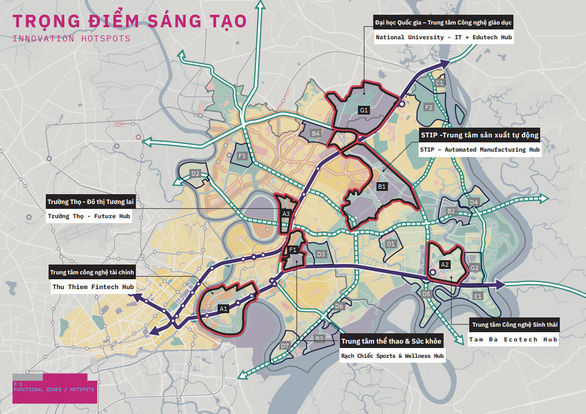The ambitious satellite city development plan of Ho Chi Minh City would be infeasible without affordable housing incentives for dwellers, an urban planning authority in Ho Chi Minh City stated.
As per official urban design plans, Ho Chi Minh City is adopting a satellite city model, with the construction of satellite towns and cities close to the downtown area.
However, the current distance between these satellite towns and the city center still dampen many urban dwellers.
Tuoi Tre (Youth) newspaper in a conversation with Tran Quoc Ngoc, architect and deputy head of the general planning management unit under Ho Chi Minh City’s Department of Planning and Architecture, clarified the functional authority of satellite cities and the implementation of construction plans.
During the construction of Thu Duc City under Ho Chi Minh City, what should be considered to facilitate the linkage between residential areas and workplaces and other public venues?
Based on the master plan, Ho Chi Minh City is envisaged to be a multicenter city, with the core being the current downtown area and five satellite cities located in the east, south, northwest, west, and southwest.
The satellite cities would offer full facilities such as medical centers, education establishments, shopping centers, greenery space, as well as other technical and transport infrastructures.
So far, the implementation [of the master plan] has yet to match the city’s stature and local leaders’ expectations.
As approved by the government, public infrastructures such as shopping centers, playgrounds, outdoor entertainment, school facilities, and medical centers must be built at residential area projects.
However, the construction of these facilities has failed to keep up with that of houses.
Especially, traffic infrastructures remain underdeveloped, prompting residents to go a long way for shopping, education, and health services.
Furthermore, there is a severe shortage of housing for workers at industrial zones, experts at the Saigon Hi-Tech Park, or staff and educators of the Vietnam National University-Ho Chi Minh City (VNU-HCM).
Meanwhile, VNU-HCM is set to become a modern university city model, with the main campus surrounded by complexes such as residential, commercial, service, educational, and medical facilities, which will serve tens of thousands of students, lecturers, and staff.
Another example is the city’s high-tech park in District 9, which houses technological companies with a high concentration of intellectuals.
Some 60 hectares of land has been set aside for housing for experts and another 20 hectares nearby has been earmarked for workers.
The housing projects, however, have seen building progress far slower than expected.
What is the department’s advice for the city to fix the problem?
To have a clearer sight of a satellite city, a place that offers both work and life facilities and nurtures both families and communities, this is a hard question.
Aside from expanding accommodations and establishing logistical and multifunctional urban centers, planning and mechanisms are two important factors.
To convince lecturers to move closer to the university campus, firstly, authorities should build facilities and public infrastructures meeting the need of white-collar workers, along with a transport network connecting to the city center.
It is believed that infrastructures, services, and jobs are always better in the city center than in newly developed areas.
Authorities should offer incentives for VNU-HCM employees so they can move near their workplace, or preferential mechanisms for property developers to implement more housing projects.
These policies can be either low-interest bank loans or preferential tax policies for investors to build affordable housing.
To formulate suitable construction policies, relevant departments should survey the needs, requirements, and conditions for those investors.
The department will consider the incorporation of the city’s housing development strategy until 2020 and with a vision toward 2030 into the adjusted construction master plan.
How will residential areas be organized following the development of Thu Duc City?
Planners will figure out accommodations for residents in the eastern area, deciding on new residential areas, and locations for renovation or reservation, all targeted at stabilizing life, protecting the current urban foundation, and facilitating sustainable development.
In your opinion, what is the ideal distance from home to facilities such as shopping centers, workplaces, public parks, and playgrounds in a city?
Recent urban planning research, with a focus on sustainable development and green transportation, recommends a reasonable distance for walking or riding a bicycle from home to work.
For walking, given a tropical climate and the physical and biological characteristics of Vietnamese people, a distance of 400-500 meters would be fine.
For biking, a 15- to 20-minute ride is recommended.
With a bus rapid transit (BRT) or metro system in place, a 10-kilometer distance or shorter is feasible.
Like us on Facebook or follow us on Twitter to get the latest news about Vietnam!

















































